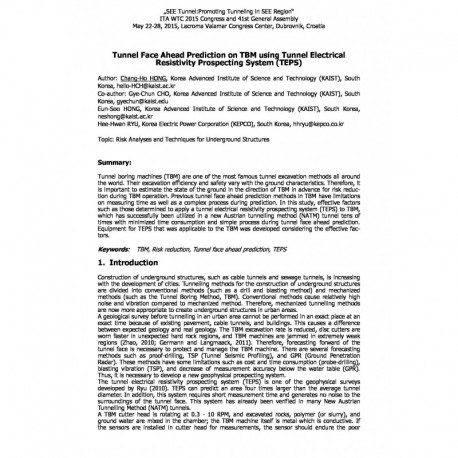Cart
0
0
No document
0,00 €
Total
Document successfully added to your shopping cart
Quantity
Total
There are 0 items in your cart.
There is 1 item in your cart.
Total documents
Total shipping
To be determined
Total
Search & filter
Search for a publication
Search & filter

Tunnel Face Ahead Prediction on TBM using Tunnel Electrical Resistivity Prospecting System (TEPS)
wtc2015_full_hong-2
G. C. Cho / H. H. Ryu / C. H. Hong / E. S. Hong
Construction of underground structures, such as cable tunnels and sewage tunnels, is increasing with the development of cities. Tunnelling methods for the construction of underground structures are divided into conventional methods (such as a drill and blasting method) and mechanized methods (such as the Tunnel Boring Method, TBM). Conventional methods cause relatively high noise and vibration compared to mechanized method. Therefore, mechanized tunnelling methods are now more appropriate to create underground structures in urban areas. A geological survey before tunnelling in an urban area cannot be performed in an exact place at an exact time because of existing pavement, cable tunnels, and buildings. This causes a difference between expected geology and real geology. The TBM excavation rate is reduced, disc cutters are worn faster in unexpected hard rock regions, and TBM machines are jammed in extremely weak regions (Zhao, 2010; Germann and Langmaack, 2011). Therefore, forecasting forward of the tunnel face is necessary to protect and manage the TBM machine. There are several forecasting methods such as proof-drilling, TSP (Tunnel Seismic Profiling), and GPR (Ground Penetration Radar). These methods have some limitations such as cost and time consumption (probe-drilling), blasting vibration (TSP), and decrease of measurement accuracy below the water table (GPR). Thus, it is necessary to develop a new geophysical prospecting system. The tunnel electrical resistivity prospecting system (TEPS) is one of the geophysical surveys developed by Ryu (2010). TEPS can predict an area four times larger than the average tunnel diameter. In addition, this system requires short measurement time and generates no noise to the surroundings of the tunnel face. This system has already been verified in many New Austrian Tunnelling Method (NATM) tunnels. A TBM cutter head is rotating at 0.3 - 10 RPM, and excavated rocks, polymer (or slurry), and ground water are mixed in the chamber; the TBM machine itself is metal which is conductive. If the sensors are installed in cutter head for measurements, the sensor should endure the poor



